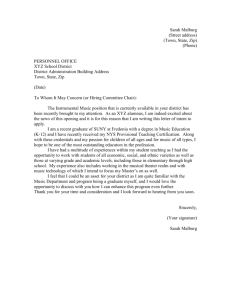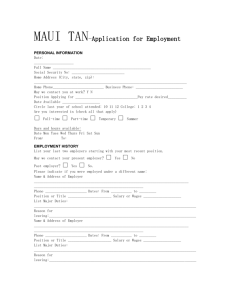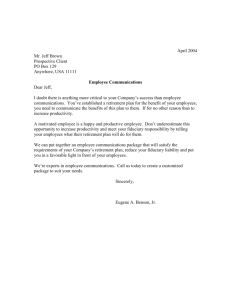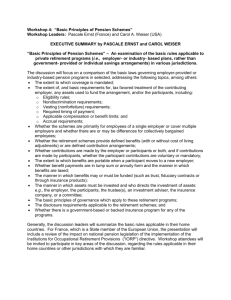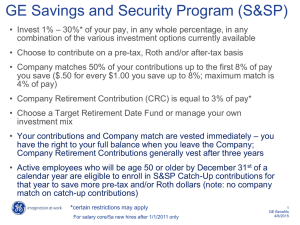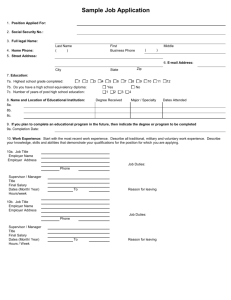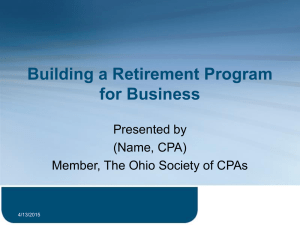EASTERN ILLINOIS UNIVERSITY
advertisement
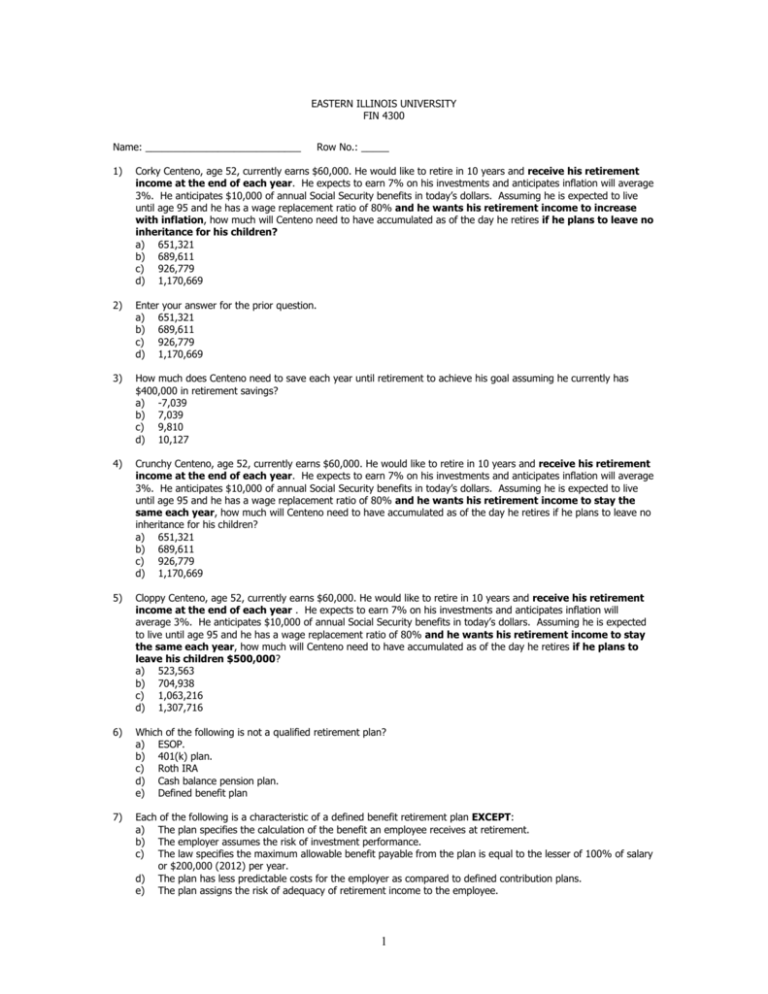
EASTERN ILLINOIS UNIVERSITY FIN 4300 Name: ____________________________ Row No.: _____ 1) Corky Centeno, age 52, currently earns $60,000. He would like to retire in 10 years and receive his retirement income at the end of each year. He expects to earn 7% on his investments and anticipates inflation will average 3%. He anticipates $10,000 of annual Social Security benefits in today’s dollars. Assuming he is expected to live until age 95 and he has a wage replacement ratio of 80% and he wants his retirement income to increase with inflation, how much will Centeno need to have accumulated as of the day he retires if he plans to leave no inheritance for his children? a) 651,321 b) 689,611 c) 926,779 d) 1,170,669 2) Enter your answer for the prior question. a) 651,321 b) 689,611 c) 926,779 d) 1,170,669 3) How much does Centeno need to save each year until retirement to achieve his goal assuming he currently has $400,000 in retirement savings? a) -7,039 b) 7,039 c) 9,810 d) 10,127 4) Crunchy Centeno, age 52, currently earns $60,000. He would like to retire in 10 years and receive his retirement income at the end of each year. He expects to earn 7% on his investments and anticipates inflation will average 3%. He anticipates $10,000 of annual Social Security benefits in today’s dollars. Assuming he is expected to live until age 95 and he has a wage replacement ratio of 80% and he wants his retirement income to stay the same each year, how much will Centeno need to have accumulated as of the day he retires if he plans to leave no inheritance for his children? a) 651,321 b) 689,611 c) 926,779 d) 1,170,669 5) Cloppy Centeno, age 52, currently earns $60,000. He would like to retire in 10 years and receive his retirement income at the end of each year . He expects to earn 7% on his investments and anticipates inflation will average 3%. He anticipates $10,000 of annual Social Security benefits in today’s dollars. Assuming he is expected to live until age 95 and he has a wage replacement ratio of 80% and he wants his retirement income to stay the same each year, how much will Centeno need to have accumulated as of the day he retires if he plans to leave his children $500,000? a) 523,563 b) 704,938 c) 1,063,216 d) 1,307,716 6) Which of the following is not a qualified retirement plan? a) ESOP. b) 401(k) plan. c) Roth IRA d) Cash balance pension plan. e) Defined benefit plan 7) Each of the following is a characteristic of a defined benefit retirement plan EXCEPT: a) The plan specifies the calculation of the benefit an employee receives at retirement. b) The employer assumes the risk of investment performance. c) The law specifies the maximum allowable benefit payable from the plan is equal to the lesser of 100% of salary or $200,000 (2012) per year. d) The plan has less predictable costs for the employer as compared to defined contribution plans. e) The plan assigns the risk of adequacy of retirement income to the employee. 1 8) Which of the following factors may affect a person’s individual retirement planning? (1) Work life expectancy. (2) Retirement life expectancy. (3) Inflation. (4) Savings rate. (a) 1 and 2. (b) 2 and 3. (c) 1, 3, and 4. (d) All of the above. 9) Which of the following is not a defined benefit plan formula(s) for calculating retirement benefits? a) Forfeiture formula b) Unit benefit (a.k.a. percentage-of-earnings-per-year-of-service) formula. c) Flat-percentage formula. d) Flat-amount formula. 10) All of the following statements concerning cash balance pension plans are correct EXCEPT: a) Defined benefit plans are converted to cash balance plans as a cost saving measure. b) The cash balance plan is a defined benefit plan. c) The cash balance plan has no guaranteed annual investment return to participants. d) The cash balance plan is subject to minimum funding requirements. 11) The following statements concerning retirement plan service requirements for qualified plans are correct EXCEPT: a) A 22 year-old employee who has worked at least 1,000 hours during the initial 12-month period after being employed is credited with one year of service. b) A 22 year-old employee who has worked at least 2,000 hours during the initial 12-month period after being employed is credited with two years of service. c) An employer has the option of increasing the one-year of service requirement to 2 years of service. d) Once an employee attains the service requirement of the plan, the employer cannot make the employee wait more than an additional six months to be considered eligible to participate in the plan. 12) Centeno Cogs sponsors a 401(k) profit sharing plan. In the current year, the company contributed 25% of each employees’ compensation to the profit sharing plan. The ADP of the 401(k) plan for the NHC was 3.5%. If Hobo Hinds, age 57, earns $100,000 and is a 3% owner, what is the maximum amount that he may defer into the 401(k) plan for this year? a) $3,500. b) $5,500. c) $17,000 d) $22,500. e) $49,000. 13) Each of the following are requirements imposed by law on qualified tax-advantaged retirement plans EXCEPT: a) Plan loans. b) Employee vesting. c) Employee participation. d) Employee communications. 14) Long Lites has a defined benefit plan with 100 nonexcludable employees (20 top dogs and 80 peons). They are unsure if they are meeting all of their testing requirements. What is the minimum number of total employees that must be covered on a daily basis to conform with the requirements set forth in the IRC for a defined benefit plan? a) 40. b) 50. c) 56 d) 70. e) 100. 15) Park Pickles has a noncontributory qualified profit sharing plan with 210 employees in total, 130 who are nonexcludable (30 top dogs and 100 peons). The plan covers 25 top dogs and 40 peons. The peons receive an average of 5.5% benefit and the top dogs receive 6.5%. Which of the following statements is (are) correct? (1) The plan meets the ratio percentage test. (2) The plan fails the average benefits test. (a) 1 only. (b) 2 only. (c) Both 1 and 2. (d) Neither 1 or 2 2 16) Which of the following qualified plans would allocate a higher percentage of the plan’s current contributions to older employees? (1) An age-based profit sharing plan. (2) A defined benefit pension plan. (3) A target benefit pension plan. (a) 1 only. (b) 1 and 3. (c) 2 and 3. (d) 1, 2 and 3. 17) Rhonda Reardanz, age 63, is a participant in the stock bonus plan of Seelhoefer Smocks, Inc., a closely held corporation. Reardanz received contributions in shares of Seelhoefer Smocks stock to the stock bonus plan and Seelhoefer Smocks, Inc. had income tax deductions for 975 shares at an average price of $16.28 per share. Reardanz terminates employment in 2006 and takes a distribution from the plan of 975 shares of Seelhoefer Smocks, Inc., having a fair value of $24,000. Which of the following correctly describes Reardanz’s tax consequences for 2012 if Reardanz sells the Seelhoefer Smocks stock for $27,000? a) Reardanz has ordinary income of $15,875 and long term capital gain of $3,000 b) Reardanz has long term capital gain of $27,000 c) Reardanz has long-term capital gain of $8,125. d) Reardanz has a long term capital gain of $11,125 18) Labbi Long owns Seelhoefer Socks, Inc. (SSI) and sells 100% of the company stock on July 1 of the current year to an ESOP for $3,000,000. Long had an adjusted basis in the SSI stock of $450,000. If Long reinvests in qualified replacement securities before the end of the current year, which of the following statements is true? a) Long will not recognize long term capital gain or ordinary income in the current year. b) Long must recognize $2,550,000 of long term capital gain in the current year. c) Long must recognize $450,000 of ordinary income in the current year. d) If Long dies before selling the qualified replacement securities, his heirs will have an adjusted taxable basis in the qualified replacement securities of $450,000, Long’s carryover adjusted basis. 19) Which of the (1) (2) (3) (4) following statements concerning stock bonus plans and ESOPs is(are) true? They give employees a stake in the company through stock ownership. They give employees a diversified portfolio for the first five years of employment. They allow taxes to be delayed on stock appreciation gains. They create a cash-flow problem for employers by requiring them to offer a repurchase option (a.k.a. put option) if their stock is not readily tradable on an established market. (a) 1 only. (b) 1,2,and 3. (c) 1,3, and 4. (d) 1,2,3 and 4. 20) Which of the following qualified plan distributions will be subjected to a 10% early withdrawal penalty? a) Looney Long, age 35, takes a $400,000 distribution from his profit sharing plan to pay for his son’s college tuition. b) Poretta Park, age 56, was terminated from Brooks Beets. Park takes a $125,000 distribution from the Brooks Beets’ retirement plan to pay for living expenses. c) Marvin Malburg, age 47, takes a $1,000,000 distribution from his employer’s profit sharing plan. Six weeks after receiving the $800,000 check (reduced for 20% withholding), Malburg deposited $1,000,000 into a new IRA account. d) Mabel Malburg, age 22, begins taking equal distributions over her life expectancy from her qualified plan. The annual distribution is $2,000. 3 21) Sala Seelhoefer turned 70½ in November of 2011. He was a participant in his employer’s profit sharing plan. His profit sharing plan had an account balance of $250,000 on December 31 of this year, and $200,000 on December 31 of last year. According to the Uniform Lifetime Table the factors for ages 70, 71, and 72 are 27.4, 26.5, and 25.6 respectively. What is Seelhoefer’s approximate required minimum distribution for 2011? a) $0. b) $7,300. c) $7,547. d) $9,124. 22) Sipper Seelhoefer turned 70½ in November of 2010. She was a participant in her employer’s profit sharing plan. Her profit sharing plan had an account balance of $250,000 on December 31 of 2010, and $200,000 on December 31 of 2011. According to the Uniform Lifetime Table the factors for ages 70, 71, and 72 are 27.4, 26.5, and 25.6 respectively. What is Seelhoefer’s approximate required minimum distribution for 2011? a) $0. b) $7,300. c) $7,547. d) $9,124. e) $9,434 23) Mabel Malburg began taking required minimum distributions from her profit sharing plan in 2004. On January 15, 2011, Malburg died after suffering a heart attack. She had not named a beneficiary of her profit sharing plan. Which of the following statements is false? a) Malburg’s estate may take a full distribution of the profit sharing plan’s assets in the year of her death. b) In the year of Malburg’s death the minimum required distribution will be equal to the minimum required distribution had Malburg not died. c) The penalty for failure to take a required minimum distribution is 50%. d) There will be no required minimum distribution for 2011 due to Malburg’s death since she died prior to June 30th. 24) Llama Long, age 51, and the owner of a llama repair shop, has come to you to establish a qualified plan. The repair shop, which employs mostly young employees, has had steady cash flows over the past few years, but Long foresees increased cash flows in the future as more llamas are deployed as security guards. Long would like to allocate as much of the plan contributions to herself as possible. She does not like her peons and does not want them to own any part of the company. All of the peons have compensation in excess of $110,000. Which of the following qualified plans would you advise Long to establish? a) Profit sharing plan (integrated). b) Defined benefit pension plan. c) Cash balance pension plan. d) Stock bonus plan. 25) Which of the following statements regarding determination letters for qualified plans is true? a) When a qualified plan is created, the plan sponsor must request a determination letter from the IRS. b) An employer who adopts a prototype plan must request a determination letter from the IRS. c) If a qualified plan is amended, the plan sponsor must request a determination letter from the Department of Labor. d) A qualified plan which receives a favorable determination letter from the IRS may still be disqualified at a later date. 26) All of the following are acceptable reasons for an employer to terminate a qualified retirement plan except: a) The employer is no longer in a financial position to make further plan contributions. b) The employer no longer wants to maintain the plan because it must cover other employees other than the owner. c) The plan benefits are not meaningful amounts, and participants are limited in their ability to make deductible IRA contributions. d) To lower plan costs and ease administrative complexity, the employer wants to switch plan designs. 27) Lobo Long operates Long Loans, a sole proprietorship. The company sponsors a profit sharing plan. The business had net income of $205,000 and paid self employment taxes of $30,000 during the year. If Long makes a 25% of salary contribution on behalf of all of his employees to the profit sharing plan, how much is the contribution to the profit sharing plan on behalf of Long? a) 35,000 b) 38,000 c) 43,750 d) 45,000 e) 51,250 4 28) Slimey Seelhoefer, age 67, has just retired. She has a balance of $1,000,000 in her 401(k) account and is in good health. What is the maximum amount she should withdraw each year if she doesn’t want to risk liquidating her account before she dies? a) 10,000 b) 20,000 c) 40,000 d) 65,000 e) 80,000 29) What is the maximum percentage of pension plan assets that can be invested in securities of the employer? a) 0% b) 10% c) 50% d) 90% e) 100% 30) A cash balance plan is: a) a defined benefit plan b) a pension plan c) both a) and b) d) neither a) or b 31) What is the automatic form of benefits for a married participant in a defined benefit plan? a) lump sum distribution b) joint and survivor annuity c) single life annuity d) required minimum distribution e) period certain annuity 32) Sally Seelhoefer saves $2,000 per year for 10 years at the end of each year starting at age 26 and ending at age 35. He invests the funds in an account earning 12% annually. Seelhoefer stops investing at age 35 but continues to earn 12% annually until she reaches the age of 65. What is the value of Seelhoefer’s account at age 65? a) $35,097 b) $482,665 c) $1,051,517 d) $1,534,183 33) Centeno Clamps has 100 peons (nonhighly compensated employees) and 20 top dogs (highly compensated employees). If 15 of the top dogs participate in the company’s defined contribution plan, what is the minimum number of peons that must participate for the plan to meet the ratio percentage test? a) 40 b) 50 c) 53 d) 75 34) Which of the following are used by actuaries to determine the annual contribution required for a defined benefit plan? i) Inflation rate ii) Life expectancy iii) Employee turnover a) i) only b) i) and ii) c) i) and iii) d) ii) only e) i), ii) and iii) 35) Loretta Long has an annual salary of $75,000 at Malburg Mats. What is the maximum annual retirement benefits Long could receive from the company’s defined benefit plan? a) $17,000 b) $50,000 c) $75,000 d) $200,000 e) $250,000 5 36) Second Row Skender’s employer uses a unit credit formula to determine employees’ annual retirement benefits of two percent per years of service times the average of the three highest years consecutive salary. Mr. Skender currently earns $80,000, has 20 years of service and anticipates a five percent raise for the next two years. Mr. Skender plans to retire three years from now. What will be his annual retirement benefit? a) 33,627 b) 36,800 c) 38,671 d) 40,000 e) 46,000 37) Lag E. Long is currently 60 years old. If she retires today she will receive an annual benefit from her employer’s defined benefit plan of $45,000. Ms. Long expects to live to age 95. What will be the increase in the current value of her defined benefit plan benefits assuming she works one more year before she retires and increases her annual benefits to $46,000 if the risk-free rate of return is 6%? a) -28,898 b) -8,513 c) 8,513 d) 16,374 e) 222,112 38) Lettuce Long has compensation of $210,000 in 2012. Her employer, Norman Napkins, has a profit sharing plan integrated for Social Security. The plan contributes 8% of base compensation and 13.7% of excess compensation over $110,100. What is the total contribution to Ms. Long’s account in 2012? a) $8,808 b) $13,686 c) $22,494 d) $28,770 e) $50,000 39) Which of the following is true regarding profit sharing plans? i) The company can make a contribution to the plan even if it had no profits during the year ii) Contributions for 2012 may be made in 2013 prior to filing the company’s 2012 tax return iii) Employer contributions to the plan are limited to $200,000 in 2012 f) i) only g) i) and ii) h) i) and iii) i) ii) and iii) j) i), ii) and iii) 40) The non-highly compensated employees (peons) of Seelhoefer Saws contributed 3% of their salary to the company’s 401(k) plan in 2012. What percent of salary are the company’s highly compensated employees (top dogs) allowed to contribute to company’s 401(k) plan in 2012? a) 1% b) 2% c) 3% d) 5% e) 6% 41) Balice Brownfield, age 53, contributes 8% of her $50,000 salary to Brooks Barks’ 401(k) plan. Her employer matches 100% of the first 3% of employee contributions and 50% of employee contributions from 3% to 7%. What is the amount of Brownfield’s income that will be subject to income taxes? a) $46,000 b) $50,000 c) $51,500 d) $52,500 e) $56,500 42) Which of the following employees of Park Pears is considered to be highly compensated? i) Rhonda Reardanz, a 6% owner, has a salary of $11,000 ii) Sally Seelhoefer, a 4% owner, has a salary of $97,500 iii) Marvin Malburg, president of the company and owns no stock, has a salary of $95,000 a) i) only b) i) and ii) 6 c) d) e) i) and iii) ii) and iii) iii) only 43) The non-highly compensated (peons) employees of Malburg Mops contributed 3.0% of their compensation to the company’s 401(k) plan. The highly compensated (top dog) employees of Malburg Mops contributed 6.5% of their compensation to the company’s 401(k) plan. Which of the following corrective actions will allow the company to pass the ADP test? i) a contribution to all non-highly compensated employees’ accounts to increase the non-highly compensated’s ADP to 4.5% ii) a matching contribution to all non-highly compensated employees’ accounts to increase the non-highly compensated’s ADP to 6.0% iii) a corrective distribution from all highly compensated employees’ accounts to decrease the highly compensated’s ADP to 6.0% a) i) only b) i) and ii) c) i) and iii) d) ii) and iii) e) iii) only 44) Which of the following is true regarding automatic enrollment in a safe harbor 401(k) plan? i) a participant’s contribution will increase in the second year unless the participant elects out of automatic enrollment ii) employer’s who auto-enroll new employees are not required to match employee contributions iii) a participant has the right to have his contributions refunded to him a) i) only b) i) and ii) c) i) and iii) d) ii) and iii) e) iii) only 45) Park Pajamas has an age weighted profit sharing plan. Clunker Centeno, age 60, has a salary of $80,000 during the year. The company’s other employee, Pavendar Park, age 25, has a salary of $20,000. If Park Pajamas contributes $30,000 to the profit sharing plan during the year and the plan’s normal retirement age is 65 and uses a discount rate of 8%, what is the amount of the contribution that will be allocated to the account of Clunker Centeno? a) $ 6,000 b) $20,000 c) $20,417 d) $29,501 e) $30,000 46) What is the amount of the contribution that will be allocated to the account of Pavendar Park? a) $ 499 b) $ 981 c) $9,583 d) $10,000 e) $24,000 47) Seelhoefer Swine has a stock bonus plan. Celilah Centeno received a distribution of 1,000 shares of the company stock in 2012 from the plan. The company took a deduction of $25 per share when contributing the stock. At the time of Centeno’s retirement the stock was valued at $15 per share. What amount of ordinary income does Centeno have if the 1,000 shares of stock were distributed to him in 2012? a) 0 b) $15,000 c) $25,000 d) $40,000 48) Seelhoefer Swine has a stock bonus plan. Celilah Centeno received a distribution of 1,000 shares of the company stock in 2012 from the plan. The company took a deduction of $15 per share when contributing the stock. At the time of Centeno’s retirement the stock was valued at $25 per share. Centeno sells the stock in 2012 for $30 per share. What amount of capital gain and ordinary game does Centeno have in 2012? a) 0 ordinary income; $5,000 long-term capital gain b) $10,000 ordinary income; $5,000 long-term capital gain c) 0 ordinary income; $15,000 long-term capital gain d) 0 ordinary income; $0 long-term capital gain 7 e) $15,000 ordinary income; $10,000 long-term capital gain and $5,000 short-term capital gain. 49) Clara Belle Centeno, age 62, has just retired from the Skender Sand Bar after setting an age-group record time in Ironman New Zealand. The company has a defined benefit plan. Ms. Centeno is married to Charlie Centeno, age 67, a sky diver who smokes 13 packs of cigarettes per day. Ms. Centeno: (1) should elect out of the automatic joint and survivor annuity (2) should take a lump sum distribution (3) was required to take a required minimum distribution from his IRA last year (a) (1) only (b) (2) only (c) (3) only (d) (2) and (3) (e) (1) and (3) 50) Lapdog Long purchased a single premium annuity for $100,000. She will receive $30,000 per year for the remainder of her life. Her life expectancy is 20 years. What portion of the annual annuity payments will be subject to Federal income tax? a) 0 b) 10,000 c) 15,000 d) 20,000 e) 25,000 51) Which of the following individuals must take a required minimum distribution from qualified plans during the year? (1) Mildred Malburg, age 72, is disabled (2) Sally Seelhoefer, age 73, is a participant in the 401(k) of Google, Inc., where is a full-time dishwasher (a) (1) only (b) (2) only (c) Both (1) and (2) (d) Neither (1) or (2) 52) On Valentine’s Day Crusty Centeno, age 73, asked Rusty Rudolphi, age 23, to marry her. If Rusty accepts: (1) Crusty’s required minimum distributions from Joey’s Hot Dog 401(k) plan will be decreased (2) Crusty’s payments from County Market’s defined benefit plan will be increased if he receives a joint and survivor annuity (a) (1) only (b) (2) only (c) Both (1) and (2) (d) Neither (1) or (2) 53) The a) b) c) d) required minimum distribution is: based on the balance in the account at the end of the prior year based on the highest balance in the account during the year is based on the secondary beneficiary’s age reduced if the owner is married and has a spouse more than 10 years older than the owner 54) Cleo Centeno, age 54, has worked for Malburg Moose for 15 years. He earns $450,000 per year and is covered by a qualified defined benefit pension plan with a funding formula of (1.5% x Years of Service x Last Years Salary). What is Centeno’s accrued annual benefit under this defined benefit plan given the funding formula, his earnings and his years of service? a) $22,500. b) $50,000. c) $55,125 d) $56,250 e) $101,250. 55) What is the percentage contribution required to be made by an employer to a safe harbor 401(k) plan? a) 1% b) 3% c) 5% d) 7% 56) If an employee contributes to a 401(k) plan because of a negative election, what percent of his salary will be contributed to the plan in the 10th year of participation if the employee does nothing to change the amount of the negative election? a) 1% b) 3% 8 c) d) e) 6% 20% 25% 57) The owners of Seelhoefer Sheep want to establish a qualified plan. Their primary goal is to retain employees as they are currently experiencing a high rate of employee turnover among their young, low paid employees. Which of the following would assist the company in accomplishing this goal? a) Integrating a profit sharing plan with Social Security b) Selecting an age weighted profit sharing plan c) Selecting a two to six year graduated vesting schedule d) Establishing a target benefit plan e) Establishing a 401(k) plan with auto enrollment 58) Which of the following plans would have the lowest administration costs? a) safe harbor 401(k) plan b) defined benefit plan c) target benefit plan d) an ESOP e) a stock bonus plan 59) The summary (1) (2) (3) plan description for a plan must: be approved by the Internal Revenue Service be provided to employees be approved by the PBGC (a) (2) only (b) (1) and (2) (c) (1) and (3) (d) (2) and (3) 60) Under a defined contribution plan, forfeitures can be: (1) allocated to remaining participants (2) reduce future employer contributions (a) (1) only (b) (2) only (c) (1) and (2) (d) neither (1) or (2) 61) Anti-allienation: (1) prevents employees from pledging their retirement benefits as collateral for a loan (2) requires employers to diversifying employees investments in a retirement plan (3) prohibits a fiduciary from charging fees for managing qualified plan assets (a) (1) only (b) (2) only (c) (1) and (2) (d) (1) and (3) (e) (2) and (3) 62) Benefits from the following qualified plans are guaranteed by the PBGC: a) 401(k) plan b) ESOP c) safe harbor 401(k) plan d) defined benefit plan e) target benefit plan 63) Which of the following types of plan termination is initiated by the PBGC: a) distress b) voluntary c) involuntary d) forfeiture e) freeze 64) Stock bonus plans: (1) require contributions every year (2) allow employers to deduct the value of the stock contributed to the plan (a) (1) only (b) (2) only 9 (c) (1) and (2) only (d) neither (1) or (2) 65) Beulah Brooks works at Brownfield Brownies. The company sponsors a profit sharing plan which requires employees to complete one year of service and be 21 years old before entering the plan. The plan has two entrance dates per year, January 1st and July 1st. Ms. Brooks is 32 years old, started work on August 22, 2009 and works 20 hours per week with no vacation time. When will Brooks enter the plan? a) July 1, 2010 b) August 22, 2010 c) January 1, 2011 d) July 1, 2011 66) Which of i) ii) iii) the following individuals is eligible to participate in Centeno Cogs qualified plan? Loretta Long, a 29 year old rocket scientist who worked 700 hours during the year Saphire Stille, a 79 year old carpenter who worked 2,200 during hours the year Mabel Malburg, a 109 year old dog washer who is a U.S. citizen and worked 4,200 hours during the year in the company’s Paris, France dog washing facility. (a) i) only (b) iii) only (c) i) and ii) (d) ii) and iii) (e) none of the above 67) Which of the following qualified plans would allocate a higher percentage of the plan’s current contributions to older employees? (1) A profit sharing plan integrated with Social Security. (2) A defined benefit plan. (3) A cash balance pension plan. (a) 1 only. (b) 2 only. (c) 2 and 3. (d) 1, 2 and 3. 68) Buford Bonic, age 26, has come to you for assistance in selecting an appropriate asset allocation for his 401(k). Bonic, likes to chew tobacco, bowl and has average risk tolerance. He left school after eighth grade to become a windshield wiper installer. Which of the following would you recommend for Bonic? a) An emerging markets small cap equity fund b) A high yield global bond fund c) A target date fund d) A money market fund e) A triple short silver ETF 69) George Gallaher, age 69, has come to you for assistance in selecting an appropriate qualified plan. Gallaher owns Gallaher Glamour Garbage which provides discreet garbage collection service for movie stars. Gallaher is distressed that his elderly peons typically quit work after eight months due to strained backs after lifting garbage bags full of empty botox bottles. Gallaher does not like his peons but is tired of looking for new peons. Gallaher earns $943,000 per year, his peons earn $9.24 per hour. Which of the following plans would you recommend? a) an age weighted profit sharing plan b) defined benefit plan c) target benefit plan d) a 401(k) plan with graduated vesting e) an integrated profit sharing plan 10
